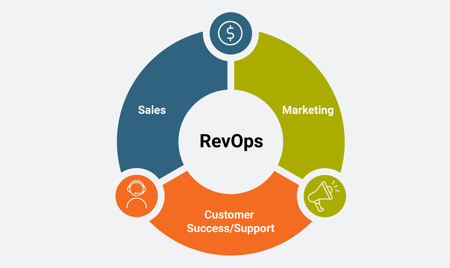Businesses must shift away from transactional thinking and focus on building long-lasting relationships with customers. Success is no longer measured by a single sale, but by lifetime value and customer service as a profit center.
However, friction exists at every contact point, hindering efficient flywheel spinning. This includes poor tools, wrong roles, and information asymmetry, all of which impede your growth.
Revenue Operations aligns and combines revenue goals across marketing, sales, and success teams. It reduces friction and ensures seamless functioning of those, driving growth and overcoming barriers.

You've merged sales, marketing, and customer success operations into one central RevOps organization. This ensures smooth data flow, cohesive tech stack, and prevents one area of the organization from interfering with another's success.
RevOps foundation
Mindset of RevOps organization
The initial step is to prime yourself with a RevOps mindset.
Get ready before implementing RevOps
Successful RevOps
- Multi Move Thinking
- Focus on the lifetime value (LTV) of bookings
- Product led growth and consultive sales
- Customer service and success are profit centers
- Sales and marketing work as one.
Not ready before implementing RevOps
RevOps failure
- Single Move Thinking
- Focus on bookings
- Agressive sales tactics that alienate leads and offer deep discounts
- Custom service and success are cost centers
- Sales and marketing bicker over success and failure
Revenue Data to be used by team everywhere
Unlock the secrets to boosting your earnings with proven revenue-boosting strategies and techniques, all grounded in solid revenue data.
Organizations should widely share revenue data but often miss or inconsistently report critical metrics like retention and lifetime value to key teams.
Marketing
How to know if a top revenue-generating channel has customers that cancel and churn quickly?
Sales
How can a sales manager know if their top salesperson is good at closing deals?
Customer Success
How can a customer success manager determine the ideal target audience for effective add-on sales?
Answers are:
To enhance revenue, it's crucial for data to be accessible and understandable across the organization. Front-line workers need to participate in decision-making, utilize personalized systems, and interact with other departments. Overlooking them hampers efficiency, akin to cooking with hands tied. Smart decision-making, underpinned by data, along with RevOps, streamlines revenue growth.
Unified goals to align teams and to grow
When properly implemented, RevOps aligns all teams under unified goals, avoiding the silos that result from organizations setting goals independently - a common issue that can lead to conflicts in fast-growing companies.

"Non-aligned marketing"
The marketing team prioritizes boosting subscriber numbers, inadvertently hindering the development of potential opportunities. Concurrently, the sales team aims to drastically enhance their conversion rates. This disparity fosters a rift between sales and marketing, not only breeding tension but also complicating the attainment of overall revenue targets.

"Non-aligned sales"
Customers acquired through aggressive discounting and sales tactics are passed to customer service with the expectation of upselling and renewals. This approach can lead to considerable confusion and frustration, particularly when assessing the engagement levels of yearly subscribers.
Success hinges on widespread data sharing and unified, revenue-focused goal-setting. Teams aligned in this way can more easily navigate departmental changes and identify operational hurdles. Embracing a unified strategy like RevOps not only offers a competitive advantage but also propels organizations toward their objectives with its clear, cohesive benefits.
RevOps Strategy
Harness brand power with data-driven insights
Branding, once considered secondary, has become paramount for monetization and retention amidst rising competition.
Positive brand affinity is directly linked to financial outcomes, with customers willing to pay 30% more for brands they like and 30% less for those they don't. Positive brand affinity also boosts retention rates by 11-18%.
The era of transactional focus has evolved. Today, creating a lasting impression is vital, requiring new levels of data analysis and patience in customer conversion. It's crucial to leverage this data beyond the initial purchase, emphasizing the enduring impact of brand on business success.
Acquisition beyond Content Marketing
In today's competitive market, innovative lead nurturing is key. While content is vital for engaging potential customers, enhancing it with strategies like the freemium model - a strategic acquisition tool rather than merely a pricing strategy - can enrich the product experience.
Freemium allows customers to explore at their pace and convert on their terms, reducing acquisition costs by 30% and improving retention rates. As acquisition costs rise and brand experience becomes more crucial, the significance of freemium models escalates.
Adapting to these changing models demands robust revenue operations for effective management.
Focus Retention that monetize easier
Acquiring customers is a major expense, consuming 57% of a business's budget, as observed in 1,819 companies. Yet, the effectiveness of traditional acquisition methods like Google Ads and content marketing is declining.
To thrive, businesses must enhance their focus on monetization and retention strategies. Currently, companies devote less than 15 hours a year to optimizing pricing and retention efforts, a figure that needs to increase for sustainable growth.
Shifting from Discounts to Long-Term Value
Relying too heavily on deep discounts and last-minute sales to meet quotas can be counterproductive. Such strategies may attract uncommitted customers leading to higher turnover and could encourage customers to leave after taking advantage of big discounts.
While modest discounts can be effective in closing sales, excessive discounting risks customer retention without careful analysis.
Understanding the lifetime value from different channels and customer segments is key to determining if your sales strategy strengthens or undermines your business's foundation.
Establish Customer Success strategy
We've shown that customer service and success, often sidelined by sales and marketing, are vital in transitioning from problem-solving to revenue-driving.
Despite beliefs, customer success strategies alone don't reduce cancellations without considering product fit, customer type, and onboarding.
Companies using customer success strategies report a 50-100% increase in expansion revenue over those who don't. Emphasizing the whole customer journey, not just the acquisition, is essential, as satisfied customers tend to increase their purchases.
Data Integrations: The Unsung Heroes
Integrations are crucial for data connectivity and enhancing customer relationships. B2B and DTC companies need to prioritize them to improve user experience and product value.
Research involving 2.4k companies and 60,000+ customers indicates a single integration can boost net retention by 15%, with retention increasing up to an additional 10% with four or more integrations.
Moreover, integrations can increase customer retention and willingness to pay by 10-30%, underscoring their importance in perceived product value.
RevOps is the key to success in the uncertain business environment.
Request a free consultation.
The first step to successful RevOps adoption.

